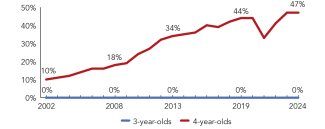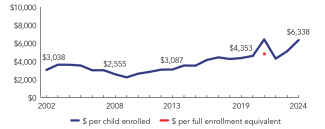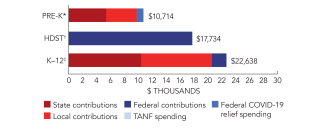
State of Preschool
Maine
Access Rankings
Resource Rankings
Total Benchmarks Met
Overview

During the 2023-2024 school year, Maine preschool enrolled 6,361 children, an increase of 124 from the prior year. State spending totaled $34,079,285, with an additional $6,234,595 in federal recovery funds to support the program, up $8,456,798 (27%), adjusted for inflation, since last year. State spending per child (including federal recovery funds) equaled $6,338 in 2023-2024, up $1,230 from 2022-2023, adjusted for inflation. Maine met 9 of 10 quality standards benchmarks.
What's New

During the 2023-2024 school year, Maine utilized funding from the Maine Jobs and Recovery Plan (MJRP) to support the expansion of public pre-K throughout the state with and without community partnerships. This expansion allowed school administrative units to open brand-new classrooms as well as expand their existing program offerings from part-day/part-week to full-day/full-week.
Maine’s Department of Health and Human Services, in partnership with Maine’s Department of Education, received an $8 million Preschool Development Grant Birth through Five (PDG B–5) renewal grant in December 2022 to build needed infrastructure and capacity to create a more coordinated, efficient, and high-quality mixed delivery system to ensure children enter Kindergarten prepared to succeed in the early elementary years. In 2023-2024, the state continued to use funding from MJRP, PDG B-5, IDEA, and leftover funds from COVID-19 Relief funding to further expand public Pre-K offerings as well as to support some districts in their efforts to take over Free Appropriate Public Education responsibilities for 3- to 5-year-old children with disabilities in inclusive settings.
Background
Maine established its Two-Year Kindergarten initiative in 1983 by allocating resources to local districts through the school funding formula. Since 2007, state-funded programs for 4-year-olds have been separately defined as the Public Preschool Program (PPP), still funded through Maine’s school funding formula, with a distribution of funds to 175 of the 198 (88%) school administrative units (SAUs) that operate kindergarten.
PPP classrooms function as either stand-alone programs located in public schools or SAUs partner with licensed community-based childcare programs or Head Start agencies. Schools are required to provide a local match to draw down a per-pupil state subsidy. The required local match is part of the school funding formula based on property value.
Maine’s Public Preschool Program Standards, promulgated as a regulation in December 2014, outlined programmatic changes including reduced child-staff ratio and group size, the use of evidence-based curricula, and child screening and assessments.
Maine Public Preschool Program
Access
Resources
| Total state pre-K spending | $40,313,880 |
| Local match required? | Yes |
| State Head Start spending | $6,140,038 |
| State spending per child enrolled | $6,338 |
| All reported spending per child enrolled* | $10,714 |

*Pre-K programs may receive additional funds from federal or local sources that are not included in this figure. †Head Start per-child spending includes funding only for 3- and 4-year-olds. ‡K–12 expenditures include capital spending as well as current operating expenditures.
Maine Quality Standards Checklist
| Policy | Requirement | Benchmark | Meets Benchmark? |
|---|---|---|---|
For more information about the benchmarks, see the Executive Summary and the Roadmap to State pages. | 9benchmarks met | ||
| Early Learning & Development Standards Benchmark | Comprehensive, aligned, supported, culturally sensitive | Comprehensive, aligned, supported, culturally sensitive | |
| Curriculum Supports Benchmark | Approval process & supports | Approval process & supports | |
| Teacher Degree Benchmark | BA | BA | |
| Teacher Specialized Training Benchmark | ECE | Specializing in pre-K | |
| Assistant Teacher Degree Benchmark | Educational Technician II (at least 9 ECE credits) | CDA or equivalent | |
| Staff Professional Development Benchmark | 6 credit hours/5 years (teachers), 3 credit hours/5 years (assistants) | For teachers & assistants: At least 15 hours/year; individual PD plans; coaching | |
| Maximum Class Size Benchmark | 16 (4-year-olds) | 20 or lower | |
| Staff to Child Ratio Benchmark | 1:8 (4-year-olds) | 1:10 or better | |
| Screening & Referral Benchmark | Vision, hearing, health & more | Vision, hearing & health screenings; & referral | |
| Continuous Quality Improvement System Benchmark | Structured classroom observations; Data used for program improvement | Structured classroom observations; data used for program improvement | |
